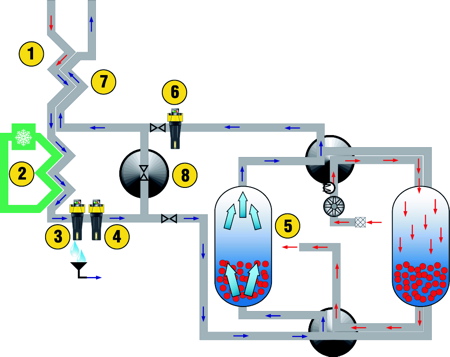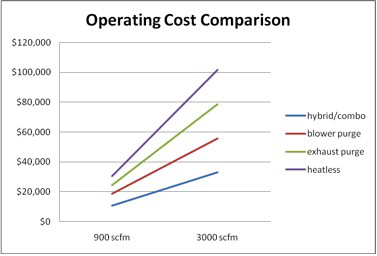Desiccant dryers are commonly used to bring the pressure dewpoint well below freezing (commonly -40°F) in order to prevent moisture from precipitating in the compressed air system and production equipment. In most cases, the need is actually seasonal and a refrigerated dryer is perfectly capable of meeting air quality needs for most of the year - and with much lower operating and maintenance costs. It is possible to install separate refrigerated and desiccant dryers in series for these applications. Better still are combination or “hybrid” dryer systems that combine dryer technologies into a high performing dryer with even lower operating costs.
|
|
These hybrid dryers first incorporate a refrigerated dryer to condense and remove the majority of the water vapor in the compressed air stream. Refrigeration is a very inexpensive method for dehydrating compressed air. Routing compressed air through a refrigeration system prior to treating it with a desiccant dryer significantly reduces the cost to produce a -40°F dew point. Refrigeration will typically remove 85% to 88% of the total amount of water vapor. The desiccant dryer is then challenged with only the remaining 12% to 15% of the total water removal.
The hybrid arrangement also significantly reduces both operating and maintenance costs compared to any other dryer types equally capable of producing -40°F dew points. The combination system also permits the refrigerated dryer to be operated independently. As the vast majority of compressed air applications simply require the water vapor remaining in the air after treatment to remain in the vapor state, a refrigerated dryer provides adequate drying during warmer months. The desiccant drying is needed only during cooler seasons. Turning off the desiccant dryer in warmer months creates significant operating and maintenance cost savings.
How a Hybrid Drying System Operates:

Hybrid Dryer Process Schematic
Compressed air that has been through a compressor’s aftercooler (typically about 100°F) enters the refrigerated dryer and passes through the primary side of the air-to-air heat exchanger (A/A HX) (1) where its temperature is reduced to about 70°F. This change in temperature condenses a significant amount of the water vapor. Some oil vapor will also be condensed in the A/A HX.
The mixture of 70°F saturated compressed air and liquid water then enters the air-to-refrigerant heat exchanger (A/R HX) (2) where the temperature is further reduced to about 38°F, condensing more water vapor to liquid, and more oil vapor to aerosols.
Next, the mixture of 38°F saturated compressed air, liquid water and oil aerosols enters the refrigerated dryer’s separator (3) where the liquid water and newly formed oil droplets are removed from the compressed air stream. The separator element also captures solid particles 3 micron and larger.
The cold saturated air continues through an oil coalescing filter (4) further reducing oil aerosol concentration to 0.01 PPMw. Particles 0.01 micron and larger are captured.
The cold, saturated, oil-free and particle-free compressed air is now passed through a bed of heated activated alumina desiccant (5) where its dew point is reduced to -40°F.
After leaving the desiccant, the cold, dry, oil-free air stream passes through a one micron particulate filter (6) to capture any desiccant fines swept out of the desiccant bed by the compressed air flow.
The final step is to route the cold, dry, oil-free and particle-free compressed air back through the secondary side of the A/A HX (7). This locks in the dew point but warming outgoing compressed air back up to 85ºF, and cools the incoming air as described in (1).
In warmer months when conditions do not necessitate lower dew point, the desiccant dryer and it’s after filter may be easily valved off (8) so that only the refrigeration dryer will operate. The air will still flow through the moisture separator (3) and the cold coalescing filter (4), and back through the A/A HX (7). In addition to significant energy savings from turning off the desiccant dryer, additional energy savings are achieved as the pressure drop across the clean air treatment system is reduced while the desiccant dryer is by-passed.
Performance Advantages:
The hybrid dryer produces a consistent outlet dew point and air temperature. There are no spikes at anytime during the drying or regeneration cycle. In fact, it will deliver outlet dew points exceeding the -40°F design when ambient conditions are less taxing than design conditions. It is not uncommon for combination systems to produce dew points in the range of -80°F during wintertime operation in cold climates. A hybrid dryers can achieve the following ISO 8573.1 classes:
• Moisture: +40 to -40º F pressure dew point Class 4 or 2
• Solids: .01 micron (exceeds Class 1)
• Oil aerosols: .01 PPMw/w (exceeds Class 2)
Energy Cost Advantages:
Hybrid dryers will consume significantly less power than other types of desiccant dryers. At rated conditions and producing a -40°F dew point for seven months per year with a 38°F dew point for the remaining five months, a combination system consumes:
* 48% less power than a blower purge dryer.
* 54% less power than a heated purge dryer.
* 64% less power than a heatless dryer.

Assumes a 8760 hours of operation at \$0.07/kWh

Assumes a 8760 hours of operation at \$0.15/kWh

Higher tolerance to elevated inlet air temperatures
Hybrid dryers significantly outperform desiccant dryers when inlet temperatures are above rated conditions. Whether due to higher ambient temperatures or inadequate compressor maintenance, the capacity of heated desiccant dryers can be severely impaired as the inlet air temperature rises. A rise of only 5°Fabove the rated inlet air temperature (100°F to 105°) results in a 13% decrease of their inlet flow capacity (i.e. a 1000 scfm dryer becomes an 870 scfm dryer). With a 10°F rise, heated dryers lose 26% of their rated capacity, and at 20°F above the rated inlet air temperature the capacity loss is 45% (a 1000 scfm dryer becomes a 550 scfm dryer)!
Hybrid dryers are not so affected by inlet temperature rising above the rated condition. It is the refrigerated dryer, rather than the desiccant dryer that will be most challenged by a rising inlet air temperature, and the effect is much less pronounced on a refrigerated dryer.
A 5°F rise of inlet air to a refrigerated dryer will result in only a slight elevation of the outlet dew point. Theoretically the dew point would rise to 41°F, and this is still a very tolerable condition for the combination system’s blower purge dryer. Any loss in performance may be imperceptible. An inlet temperature rise of 10°F would have a discernable impact; however, the refrigerated dryer would lose only 18% of its rated capacity compared to the 26% loss a heated dryer would have.
Maintenance and service advantages:
Lower desiccant replacement costs:
Since the refrigeration component removes 85% of the moisture, the desiccant beds, heater and blower can be sized much smaller for a hybrid dryer than a stand-alone desiccant dryer. Consequently, the cost of desiccant replacement is much lower. For example, a 1500 scfm heated exhaust purge or blower purge dryer requires 2520 lbs of desiccant and a similar capacity heatless dryer holds 2060 lbs. By contrast, a hybrid dryer only needs 1560 lbs of desiccant for the same flow.
In addition, the service intervals for the desiccant in a hybrid dryer are less frequent:
• Heated dryers--replace desiccant every two years
• Heatless dryers –replace desiccant every three to five years.
• Hybrid dryer—replace desiccant every five to seven years.
The longer desiccant service in combination systems results from several factors:
(1) It is not used all year long.
(2) Less thermal cycling - the desiccant beds in hybrid systems are heated and cooled half as often as other heated dryer types. The desiccant is regenerated every eight (8) hours in hybrid systems where regeneration every four (4) is typical of other heated dryer types.
(3) Magnitude of thermal cycling is reduced - the regeneration temperature for blower purge dryers in hybrid dryers is only 230°F to 250°F, compared to a typical regeneration temperature of 400°F to 425°F in other heated dryers. Therefore the temperature change of the desiccant during regeneration is only about 200°F (40°F inlet to 240°F) compared with a temperature change of 300ºF (100ºF to 400ºF) in traditional dryers.
(4) Hybrid systems have slower, controlled depressurization of the desiccant tower in preparation for regeneration. The tower is depressurized over a period of several minutes rather than seconds as with heatless desiccant dryers. This eliminates high air velocities in the desiccant beds that cause desiccant to breakdown. And it occurs far less frequently than heated or heatless dryers.
Combining smaller desiccant beds with less frequent service intervals yields much lower average annual desiccant replacement costs for the hybrid unit:
Average Desiccant Replacement Quantity
• Heated: 2520 lb x 1 change/2 years = 1260 lb/yr
• Heatless: 2060 lb x 1 change/5 years = 412 lb/yr
• Hybrid: 1560 lb x 1 change/7 years = 223 lb/yr
Reduced tower switching and valve cycling.
The hybrid dryer’s 16 hour cycle ( 8 hours drying, 8 hours regenerating) greatly reduces valve cycles. Heated dryers typically operate on an 8 hour cycle, so they have double the valve actuation cycles than in a hybrid system. The valves in a hybrid system cycle 99% less than a typical heatless dryer, which commonly cycle every 5 minutes. The result is less wear and longer valve life in the hybrid dryer.
Other maintenance benefits
Routine maintenance for the blower purge dryer, such as filter element replacement, valve rebuilds, even desiccant replacement, can be performed without having to schedule air system downtime.
The need to stock routine maintenance items (such as filter elements, valve rebuild kits and replacement desiccant) is eliminated along with the associated administrative costs of those functions as well as keeping warehouse space free for other uses.
Why not just by two dryers?
Some energy-wise users have invested in both refrigerated and desiccant dryers, running them separately in accordance with the season. This definitely presents energy savings compared to running a desiccant dryer all year long, but it does not achieve the benefits of the hybrid dryer.
• Cost of purchasing and installing two separate dryers is higher.
• Inlet air to the desiccant dryer is not pre-cooled or cold filtered, so the performance is lower.
• The desiccant dryer must be sized for full-flow, so the user will not realize all the maintenance benefits.
Total Cost Comparison
As illustrated in the operating cost comparisons above, the larger the system, the greater the difference in savings. The total cost comparison (including purchase price, operating and maintenance) shows a similar pattern. Even with purchase costs included, the hybrid dryer achieves a very fast payback of capital invested:
• In a 900 scfm system, the break-even point with the next best alternative is 3.2 years.
• In a 1500 scfm system, the break-even point with the next best alternative is 1.5 years
• In a 5000 scfm system, the hybrid dryer costs dip below the next best alternative in just 10 months.
Conclusion:
A combination refrigerated/desiccant compressed air dryer is a flexible drying system capable of consistently high performance and reliability with low operating and maintenance costs that quickly returns the difference of the initial purchase price, and then goes on to provide years of significant operations and maintenance savings.
To download a complete copy of the white paper on hybrid dryers, please visit www.kaeser.com/combodryers.
For more information contact David Phillips, Product Manager, Clean Air Treatment, Kaeser Compressors, tel: 540-834-4510, www.kaeser.com.
To read more Air Treatment articles please visit www.airbestpractices.com/technology/air-treatment.

 David Phillips, Product Manager, Clean Air Treatment, Kaeser Compressors
David Phillips, Product Manager, Clean Air Treatment, Kaeser Compressors


